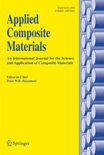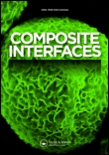
APPLIED COMPOSITE MATERIALS
Scope & Guideline
Charting New Territories in Composite Applications
Introduction
Aims and Scopes
- Mechanical Properties and Behavior of Composites:
The journal consistently publishes research on the mechanical properties of composite materials, examining factors such as tensile strength, impact resistance, and fatigue behavior. This includes studies on how different fiber types, orientations, and composite structures influence these properties. - Manufacturing Techniques and Process Optimization:
A significant focus is placed on various manufacturing techniques for composite materials, including additive manufacturing, resin transfer molding, and fiber-reinforced processes. Research often explores optimizing these processes to improve material performance and reduce manufacturing costs. - Damage Mechanisms and Failure Analysis:
The journal emphasizes understanding the damage mechanisms and failure modes in composite materials. This includes experimental and numerical analyses of damage under various loading conditions, environmental effects, and the impact of manufacturing defects. - Innovative Composite Applications:
Research on innovative applications of composite materials in fields such as aerospace, automotive, and construction is a core area. This includes the development of new composite structures and materials tailored for specific applications. - Multiscale Modeling and Simulation:
The journal publishes studies that employ multiscale modeling techniques to predict the behavior of composite materials under different conditions. This includes computational methods that integrate microstructural analysis with macroscopic material behavior. - Sustainable and Bio-based Composites:
An emerging focus on sustainability is evident, with research exploring bio-based composites, recycling, and eco-friendly manufacturing processes. This reflects a growing trend toward reducing environmental impact in composite material production.
Trending and Emerging
- Machine Learning and Artificial Intelligence Applications:
Research applying machine learning techniques to predict material behavior, optimize manufacturing processes, and assess damage is gaining traction. This trend highlights the integration of advanced computational techniques in composite research. - Hybrid and Multifunctional Composites:
There is an increasing focus on developing hybrid composites that combine multiple materials to achieve superior properties. This trend includes studies on multifunctional composites that serve more than one purpose, such as structural integrity and energy absorption. - Nanocomposites and Advanced Reinforcements:
The use of nanomaterials as reinforcements in composites is emerging as a significant area of research. Studies are exploring the effects of nanoparticles, such as graphene and carbon nanotubes, on the mechanical and thermal properties of composites. - Sustainability and Recycling Processes:
Research into sustainable composite materials and recycling methodologies is on the rise. This includes the development of biodegradable composites and the exploration of ways to recycle existing composites to reduce environmental impact. - Smart Composites with Embedded Sensors:
The trend towards smart composites that incorporate sensors and actuators for real-time monitoring of structural health is emerging. This innovative approach aims to enhance the safety and reliability of composite structures in various applications.
Declining or Waning
- Traditional Composite Materials:
There seems to be a waning interest in traditional composite materials such as pure glass or carbon fiber composites without any novel enhancements or modifications. Researchers are increasingly exploring advanced composites that incorporate new materials or hybrid structures. - Static Analysis without Dynamic Considerations:
Research focusing solely on static analysis of composites without considering dynamic responses or real-world loading conditions is becoming less frequent. The trend is shifting towards studies that incorporate dynamic testing and real-time monitoring of composite behavior. - General Reviews without Specific Applications:
There has been a decline in general review articles that do not focus on specific applications or advancements in composite materials. The emphasis now appears to be on targeted studies that provide practical insights or novel methodologies.
Similar Journals

Revue des Composites et des Materiaux Avances-Journal of Composite and Advanced Materials
Advancing the Future of Material ScienceRevue des Composites et des Materiaux Avances - Journal of Composite and Advanced Materials is a prominent academic journal published by the INT INFORMATION & ENGINEERING TECHNOLOGY ASSOC, based in France. With an ISSN of 1169-7954 and an E-ISSN of 1958-5799, this journal serves as a critical platform for the dissemination of innovative research in the field of composite and advanced materials. Currently categorized in the Q3 quartile of Materials Science and ranking 326 out of 463 in its category according to Scopus, the journal aims to bridge the gap between theoretical advancements and practical applications in material science. As it embraces an open-access model to increase accessibility, it caters to a diverse audience, including researchers, professionals, and students interested in cutting-edge materials technology. The journal covers a wide scope of topics ranging from manufacturing processes to material characterization, contributing significantly to the ongoing discourse in this evolving field. With convergence years extending from 2012 to 2024, it is poised to be an essential resource for anyone looking to stay abreast of the latest developments in composite science.

COMPOSITE STRUCTURES
Transforming Ideas into Impactful Engineering SolutionsComposite Structures, published by Elsevier Science Ltd, is a premier academic journal that has been at the forefront of research in the fields of Ceramics and Composites and Civil and Structural Engineering since its inception in 1983. With a remarkable Q1 ranking in both categories for 2023, it is recognized as one of the leading publications, occupying the 22nd position in Civil and Structural Engineering and the 14th in Materials Science, showcasing its high-impact contributions to the respective fields. The journal serves as a crucial platform for disseminating cutting-edge research, innovative methodologies, and comprehensive reviews that cater to the academic and professional community. Although it does not offer open access options, its robust impact factor and extensive reach through Scopus ensure that the articles published are widely cited and serve as valuable resources for enhancing the understanding of composite materials and structures. The journal invites contributions that push the boundaries of knowledge, making it an essential read for researchers, engineers, and students invested in advanced materials and structural applications.

COMPOSITE INTERFACES
Elevating Knowledge in Composite Interfaces and MaterialsComposite Interfaces is a prominent journal dedicated to advancing the scientific understanding and applications of composite materials and interfaces, published by Taylor & Francis Ltd. Since its inception in 1993, this journal has become a pivotal resource for researchers and practitioners in the fields of ceramics and composites, as well as in physics and materials sciences. With a commendable Q2 ranking in 2023 across multiple categories, including Ceramics and Composites, Physics and Astronomy, and Surfaces, Coatings and Films, Composite Interfaces ensures a high standard of scholarly excellence, reflected in its robust Scopus rankings. While the journal operates under a subscription model, its influential body of work is vital for those seeking to innovate in composite material applications. By fostering scholarly communication, Composite Interfaces plays a crucial role in the progression of material science, an area of increasing relevance in technology and engineering.

International Journal of Mechanical and Materials Engineering
Exploring New Frontiers in Mechanical and Materials ScienceInternational Journal of Mechanical and Materials Engineering is a renowned, open-access journal published by SPRINGER that has established itself as a key platform in the fields of Mechanical Engineering, Materials Science, and Industrial and Manufacturing Engineering. With an impressive Q2 ranking in multiple categories for 2023, including Mechanics of Materials and General Materials Science, the journal provides high-quality research and innovative insights that are critical for advancing the engineering disciplines. Since its inception in 2007, the journal has been pivotal in disseminating knowledge and fostering dialogue amongst researchers, professionals, and students, with the open access model facilitating widespread distribution of its content since 2014. The journal’s affiliation with a prestigious publisher in Switzerland enhances its credibility and reach, making it an invaluable resource for those engaged in cutting-edge research and development in mechanical and materials engineering. With an ISSN of 1823-0334 and an E-ISSN of 2198-2791, this journal invites submissions that contribute to the academic community and inspire future engineering solutions.

Journal of Polymer & Composites
Advancing Innovations in Polymer Science and Composite Materials.Journal of Polymer & Composites, with ISSN 2321-8525 and E-ISSN 2321-2810, is an esteemed academic journal published by STM JOURNALS, dedicated to the advancement of knowledge in the rapidly evolving fields of polymer science and composite materials. The journal serves as a pivotal platform for researchers and professionals, offering cutting-edge research articles, reviews, and case studies that explore innovative developments and applications in polymer chemistry, material science, and engineering. Although currently lacking an impact factor citation, the journal aims to foster dialogue among academia and industry partners, addressing the latest trends and breakthroughs that drive the field forward. With a commitment to scholarly excellence, the Journal of Polymer & Composites is positioned as an essential resource for enhancing the understanding of polymer composites and their multifaceted applications. Notably, STM JOURNALS' reputation for quality publications underscores the journal’s importance in facilitating impactful research and educational initiatives worldwide.

Functional Composites and Structures
Driving Innovation in Composite Applications.Functional Composites and Structures is a prestigious academic journal published by IOP Publishing Ltd, dedicated to advancing the field of materials science with a focus on innovative composite materials and their structural applications. Established in 2019 and running through 2024, this journal uniquely bridges several disciplines, consistently ranking in the Q2 quartile across key categories including Ceramics and Composites, Electronic, Optical and Magnetic Materials, and Mechanics of Materials. With a commendable Scopus rank that places it within the top tiers of its field, the journal is instrumental for researchers, engineers, and scholars seeking to explore the latest developments in material properties, functionality, and applications. Although access options are not specified, the open-access nature of the journal promotes wider dissemination and engagement with cutting-edge research. As the demand for smarter, more efficient materials continues to grow, Functional Composites and Structures serves as a vital resource for fostering collaboration and driving innovation in material sciences.

Forces in Mechanics
Empowering Scholars with Open Access KnowledgeForces in Mechanics is a premier open access journal published by ELSEVIER that has carved out a significant niche in the realms of Mechanical Engineering and Mechanics of Materials. Established in 2020 and based in the Netherlands, this journal aims to disseminate high-quality research that explores the fundamental principles and applications of forces within mechanical systems. It operates under the ISSN 2666-3597, showcasing a dedication to transparent and accessible research for scholars around the globe. With a 2023 impact factor ranking placing it in the Q2 quartile for both Mechanical Engineering and Mechanics of Materials, the journal is recognized for its contributions to the field, evidenced by its Scopus ranking—285th in Mechanical Engineering and 184th in Mechanics of Materials, placing it in the 57th and 53rd percentiles, respectively. The journal publishes original research articles, reviews, and technical notes, catering to a diverse audience including researchers, practitioners, and students who are keen to advance their knowledge on the dynamics of forces in mechanical contexts. As it converges from 2021 to 2024, Forces in Mechanics remains committed to providing a platform for innovative research and critical discourse, ensuring that all published work is freely available to the global community.

Elastomers and Composites
Fostering Collaboration in Elastomeric ResearchElastomers and Composites is a leading academic journal dedicated to the advancement of knowledge in the fields of polymer science and materials engineering, specifically focusing on elastomers and composite materials. Published by RUBBER SOC KOREA, this journal serves as a vital platform for researchers and professionals to disseminate innovative research findings and insights in material properties, applications, and synthesis techniques. Although it currently does not offer open access, the journal provides rigorous peer-reviewed content that enhances the global dialogue on elastomeric materials and their composites, reflecting its commitment to high-quality scholarship. With a strong emphasis on practical relevance and theoretical advancements, Elastomers and Composites aspires to reshape industry practices and academic thought, making it an invaluable resource for students, researchers, and practitioners alike. Positioned strategically within its field, this journal fosters collaboration and dialogue among scientific communities, all while supporting the growth of cutting-edge research programs worldwide.

COMPOSITES PART B-ENGINEERING
Exploring New Frontiers in Composites and CeramicsCOMPOSITES PART B-ENGINEERING, published by Elsevier Science Ltd, stands at the forefront of research in the fields of engineering and materials science, specifically targeting the domains of composites, ceramics, and mechanical engineering. With an impressive impact factor and categorized in the prestigious Q1 quartiles across multiple categories including Industrial and Manufacturing Engineering and Mechanics of Materials, this journal fosters innovative research that significantly contributes to the advancement of composite materials and their applications. The journal has been diligently publishing high-quality peer-reviewed articles since its inception in 1996, and it continues to attract top-tier contributors and researchers who are dedicated to exploring emergent technologies and methodologies. Researchers, professionals, and students will find valuable insights and an extensive pool of resources in this essential journal, available through Open Access options that enhance its visibility and reach, allowing the dissemination of crucial knowledge to the global scientific community.

JOURNAL OF THE MECHANICAL BEHAVIOR OF MATERIALS
Advancing Knowledge in Material BehaviorJOURNAL OF THE MECHANICAL BEHAVIOR OF MATERIALS, published by DE GRUYTER POLAND SP Z O O, is a prominent open-access journal in the field of materials science and mechanics, dedicated to facilitating the dissemination of high-quality research findings since 2019. With an ISSN of 0334-8938 and an E-ISSN of 2191-0243, this journal provides a platform for researchers, professionals, and students to explore the mechanical behaviors of various materials, crucial for advancing engineering and scientific applications. The journal's impact is evidenced by its impressive rankings, including Q2 status in both Materials Science (miscellaneous) and Mechanics of Materials as of 2023. With a Scopus rank placing it in the top-half of indexed journals, the JOURNAL OF THE MECHANICAL BEHAVIOR OF MATERIALS is a vital resource for anyone looking to stay at the forefront of material behavior research. Based in Germany, it serves the global academic community while catering to the evolving needs of industry practitioners through its comprehensive open-access model.